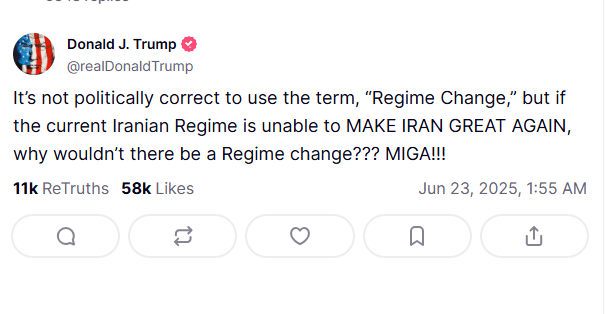Iran Warns U.S. as Tensions Escalate: “You May Start the War, But We Will End It”
Amid rising fears of a US Iran war, Iran has declared that recent U.S. airstrikes on its nuclear facilities have dramatically expanded the range of legitimate military targets. The Islamic Republic directly blamed former President Donald Trump for pushing the region toward a broader conflict by aligning Washington with Israel’s aggressive campaign.
data-start=”588″ data-end=”969″>This stark warning has fueled growing speculation that a US Iran war may no longer be a distant possibility but a rapidly approaching reality. Early Sunday morning, the U.S. launched bunker-buster strikes on Iranian nuclear sites in support of Israel’s ongoing offensive. Iran has since vowed retaliation, claiming it now sees a wider array of U.S. assets as potential targets.
<p data-start=”971″ data-end=”1321″>While Tehran continues to bombard Israeli positions with missile strikes, it has so far avoided direct confrontation with the U.S. military. No American bases have been attacked, and the vital oil shipping route through the Strait of Hormuz remains uninterrupted, despite its strategic importance as a passageway for nearly 20% of global oil exports.
In a fiery address, Ebrahim Zolfaqari, spokesperson for Iran’s Khatam al-Anbiya central command, issued a bold challenge:
“Mr. Trump, the gambler—you may start this war, but we will be the ones to end it.”
His statement, delivered partly in English via a recorded video, signaled a sharp escalation in Iran’s warnings toward Washington.
The region now watches anxiously as the situation continues to unfold, with global leaders urging de-escalation before the conflict spirals further out of control.
https://x.com/RT_com/status/1937038083595354557
Iran and Israel exchanged another round of air and missile strikes on Monday, intensifying fears around the globe as anticipation mounted over how Tehran would respond.
The Trump administration has consistently stated that its objective is to dismantle Iran’s nuclear program, not to spark a broader regional conflict.
However, in a social media post on Sunday, former President Donald Trump hinted at a more aggressive agenda—suggesting the removal of Iran’s ruling clerics, who have remained a central adversary of the U.S. since the 1979 Islamic Revolution.
“It’s not politically correct to use the term ‘Regime Change,’ but if the current Iranian Regime is unable to MAKE IRAN GREAT AGAIN, why wouldn’t there be a regime change??? MIGA!!!” Trump wrote.
 Satellite imagery suggests the U.S. strike heavily damaged Iran’s Fordow nuclear facility, possibly destroying its centrifuges, though independent confirmation is still pending.
Satellite imagery suggests the U.S. strike heavily damaged Iran’s Fordow nuclear facility, possibly destroying its centrifuges, though independent confirmation is still pending.
“Massive damage was inflicted on all of Iran’s nuclear sites,” he wrote. “The most severe destruction occurred deep underground.”

US Iran War Fears Surge Amid More Israeli Strikes and Rising Tensions
US Iran war fears are intensifying as more Israeli strikes and rising tensions engulf the Middle East. Israel has ramped up its air campaign against Iran, carrying out powerful strikes with little resistance from Iranian air defenses. This follows the deadly June 13 assault that killed several high-ranking Iranian commanders and further escalated the regional conflict.
On Monday, the Israeli military reported that around 20 fighter jets executed coordinated attacks on Iranian military infrastructure in both western Iran and Tehran. Key radar and missile systems in Kermanshah were destroyed, and a surface-to-air launcher in Tehran was also hit. Iranian media confirmed that air defenses in central Tehran were activated, and the Parchin military complex—located southeast of the capital—was also targeted.
Iran claims over 400 deaths, mostly civilians, from Israeli strikes. However, limited visual evidence has surfaced since the start of the bombardment. The capital, Tehran, home to 10 million people, is seeing mass evacuations as citizens flee to safer rural areas.
In retaliation, Iran has launched missile strikes into Israel, breaching its defenses for the first time in years. These strikes have killed 24 civilians and injured hundreds. Overnight, another missile was intercepted, prompting air raid sirens in Tel Aviv and nearby regions.
Strategic Shifts and Limited Retaliation
Iran’s response options are growing increasingly limited. The recent fall of two major Iranian allies—Hezbollah in Lebanon and Syrian President Bashar al-Assad—has weakened Iran’s regional influence. As a result, Tehran is struggling to deliver a sustained counterattack.
One of Iran’s last significant levers is its control over oil flow through the Gulf. On Monday, oil prices surged past $80 per barrel amid speculation that Iran might move to close the Strait of Hormuz—a vital passage for 20% of global oil trade. Though Brent crude later dropped to $76.64, markets remain jittery.
Iran’s parliament has approved a measure to shut down the Strait, pending final approval by the Supreme National Security Council. Such a move could draw the U.S. Navy’s Fifth Fleet, based in Bahrain, into direct conflict—paving the way for a full-blown US Iran war.
U.S. Secretary of State Marco Rubio issued a stark warning: “It would be economic suicide if they tried. And we have options to respond.”
Diplomatic Maneuvers and Global Reactions
Meanwhile, Iran’s Foreign Minister Abbas Araqchi is set to meet with Russian President Vladimir Putin in Moscow. Although Russia maintains alliances with both Iran and Israel, it may play a critical role in de-escalation efforts.
Speaking in Istanbul, Araqchi declared that Iran would exhaust all possible responses and ruled out returning to diplomacy until it had taken revenge. Russian state media later reported that Moscow and Tehran are now closely coordinating their positions.
With rising casualties, unstable oil markets, and the looming possibility of a US Iran war, the world watches closely as the region edges toward a broader, deadlier conflict.


















